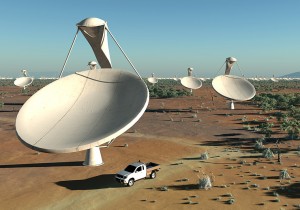
A global science and engineering project named The Square Kilometre Array, has been in intense political negotiations since the project was first introduced. The project intends to build the world’s largest radio telescope, with it’s main objective set to answer big questions about the universe, such as how the first elements heavier than helium was formed and how the first galaxies coalesced. The project is led by the SKA Organisation, a not-for-profit company with its headquarters in Manchester, UK.
At first a scientific panel recommended South Africa over Australia as the best site for the proposed Square Kilometre Array (SKA). However in the latest plans announced on May 25, South Africa and Australia will share the Square Kilometre Array. The project is made up of 3,000 dishes, 15 meters in diameter, and an even larger number of simple antennas and will cost approximately $1,9 billion ( €1,5 billion). Under the deal, South Africa will host the dishes, and Australia will get the antennas.
The new decision followed a straw poll of the voting members of the SKA board: Italy, Canada, the United Kingdom, China and the Netherlands. The nations have so far contributed a total of €90 million to the project’s pre-construction phase and following the site decision, further commitments are expected to follow by 2014. The decision may have satisfied a few local politicians fighting for the project, but has also left some scientists worrying about potential logistical problems that in turn could lead to cost increases, and ultimately jeopardizing the telescope’s long-term future.
Radio telescopes detect radio-frequency signals from space, and provide an alternative view of the Universe to those seen with an optical telescope. By using radio telescopes it is possible to analyse and reveal areas of space that otherwise may be obscured with cosmic dust and therefore hidden from optical telescopes. Astronomers and engineers from more than 70 institutes in 20 countries are designing the SKA, and when completed it will be 50 times more sensitive, and will survey the sky 10,000 times faster than any other radio telescope currently available.
The SKA will operate as a global telescope, and the data will be processed in centers around the world. Signals received by the SKA will be transferred to a central high performance super computer by optical fiber, and the rate at which the vast quantities of data will be transferred to the supercomputer will far exceed the data rates of current Internet traffic.
The project’s sheer scale makes it necessary to split the building work into two phases. In the first phase, due to begin as early as 2016, South Africa will add 190 steerable dishes to its existing MeerKAT array and Australia will add 60 dishes to its SKA Pathfinder facility. They will also build half a million omni-directional dipole antennas that are cheap, stubby devices that capture radio signals across the sky and assemble them into an image. The result will be an Australian telescope with a wide-angle view of the sky, and a South African telescope with a narrower view, and higher sensitivity.
In phase two, additional dishes will be assembled in South Africa and eight other African countries, along with mid-frequency aperture arrays. These will fill an observing gap between the antennas and the dishes, and at the same time Australia will build the remaining dipole antennas needed. As phase two comes to play, and the SKA telescope grows, it will require an ever-increasing amount of electricity, dedicated fibre-optic networking and supercomputing resources to channel and crunch its data. There is not yet a detailed plan for phase two of the project, but it will most likely lead to increasing costs with up to 30%.
